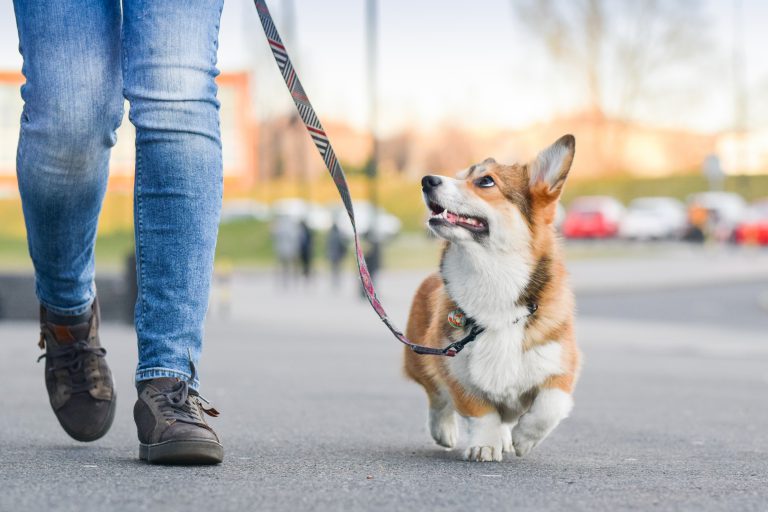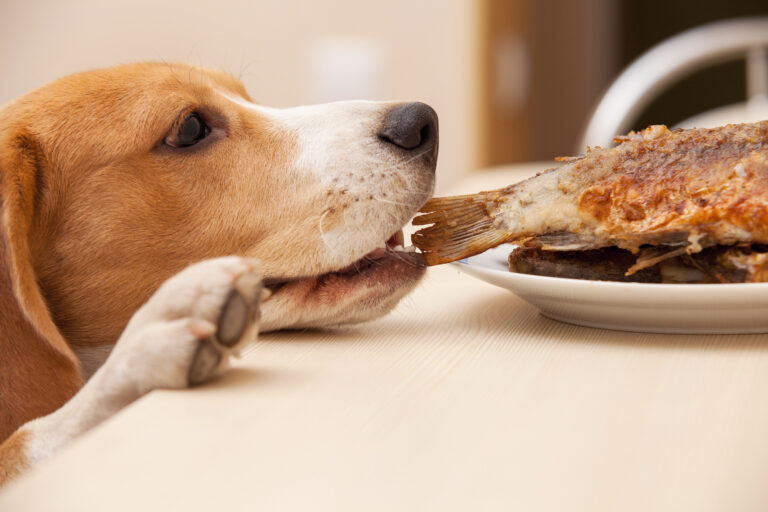From dropped food and mysterious sidewalk trash to passing cyclists and other dogs, there’s no shortage of distractions and potentially dangerous obstacles and ephemera that your dog will encounter every day. And one of the best ways to protect your four-legged friend from potential fallout from these interactions is to teach them to “leave it.”
“Leave it” is a relatively advanced—but very important—skill to teach your dog. A strong “leave it” can prevent fights, protect dogs from the stomach-battering effects of street treats, and all-round improve, or even save lives. Here’s a step-by-step guide to teaching your dog to leave it.
How long does it take to teach a dog to “leave it”?
Every dog is different, so there’s no definitive timeframe for learning this skill. Experts say it can take anywhere between two and six weeks to teach a dog how to leave it, and the more biddable, or eager-to-please, your dog, the faster they’ll learn. Certain breeds who are both intelligent and biddable, such as border collies, can learn “leave it” in only a few sessions.
To speed up the learning process, practice every day for about 10-15 minutes. The more you practice, the faster your dog will pick it up—but only to a degree. Just like with toddlers, dogs can become frustrated and start misbehaving or ignoring you all together, which means you might need to keep sessions relatively short. What’s more important than the amount of time per day is the consistency of training every day. Even if it’s taking longer than you expected, keep at it.
How to teach your dog to “leave it”
Due to the nature of this command, your dog will learn in stages.
Teaching them to take only when given permission
First things first: your dog needs to understand that they must be given permission to take something before they can learn to leave something. That means teaching them to ignore things they’re interested in.
Here’s a step-by-step guide to creating this foundation:
- Put a low- to mid-value treat in your hand, fist closed, and let your dog sniff, lick, and attempt to get the treat.
- When your dog loses interest in and turns away from the treat, immediately mark the behavior by praising them with a “yes,” or “good dog,” then open your hand and give them the treat while saying “okay” or “take it.”
- Do this until they start to ignore your closed fist from the start. When they do that, open your palm to show them the treat. If they reach for the treat, close your hand and say “no.” The goal is to teach them that they can only take something when you tell them, “okay” or “take it.” Present your open palm again and continue this process until they start losing interest in your open hand as well. Then tell them “okay” or “take it.”
- Every time you do this, make the pause between opening your hand and giving the command a little longer until they understand that the command is not the opening of the palm but a verbal command that you give.
The goal is to get to a place where your dog realizes that the mere sight of a treat does not give them permission to take it.
Teaching your dog to ignore temptation
Now that your dog is able to take only when given permission, you can start testing their ability to ignore stimuli when you tell them “leave it.” Make sure that before you start teaching the “leave it” command, the “leave it” behavior is reliable—your dog has figured out that leaving something gets them rewarded.
Paramount to this skill is teaching your dog that a high value treat—arguably higher value than whatever they want to engage with—is waiting for them if they listen to your command. Here’s how you do this:
- As with the “take it” skill, present a treat in a closed fist to your dog. Tell them, “leave it.” Do this several times to create an association between ignoring the item and the words, “leave it.”
- When they start reliably turning their head away, switch gears slightly. Present your closed fist and immediately say “leave it” instead of after they turn away. The goal is to switch the verbal direction to a command, rather than words associated with an act they’re already performing.
- When they ignore the treat at “leave it,” present them with a high value treat from your other hand. The goal is to teach them that listening to this command will result in a better reward than if they reached for the treat in your hand.
Trail of treats
You can take “leave it” to the next level by dropping or placing the treat near your foot. Practice the command “leave it,” rewarding with a treat from your hand when they ignore the treat on the floor.
Finally, you’re going to make an obstacle course of sorts in order to solidify their “leave it” cue. While your dog is out of the room, lay out a line of treats. Walk them on leash by the treats, cuing “leave it” every time you pass a treat.
When they ignore the treat on the ground, give them a high value treat from your hand and praise them. If they lunge for the treat on the ground, cover the treat with your foot and tell them, “no.” Eventually, your dog should be able to walk by the entire row without lunging for a single treat on the ground. Giving them the high-value treat from your hand, instead of the treat on the floor is important, as you want them to learn not to expect to eventually get the floor-treat (there are many things in the real world that you really want them to leave alone).

Focusing on the highest value treat of all
A more advanced technique
Walking past desirable items in a controlled environment is a great foundation, but to really make sure your dog’s “leave it” is strong, the next step is to start practicing out in the world.
Start with a short walk in your neighborhood during a quiet time of day. The goal is to start building this skill in familiar environs with minimal distractions.
Tell them to leave less valuable distractions. What constitutes a less valuable distraction will depend largely on what your dog responds to, but some examples are used napkins or empty fast food bags on the ground. From there, you can start asking them to leave more valuable things alone, such as bits of food.
For dogs who need to learn “leave it” to ignore passersby, you’re going to build in a similar way. Start by asking them to ignore pedestrians.
Make sure you’re giving them the “leave it” command when they are about to move toward the target, not after they’ve gotten too close, at which point they’re less likely to follow the direction. As with addressing reactivity, take it slow and give your dog ample space from tempting or offending objects to calmly react to your command.
From there, you can start asking them to ignore more distracting passersby, such as runners, skateboarders, and cyclists. In these more difficult contexts, where your dog’s reaction may stem from other factors beyond just wanting to eat a treat or say hello, it can be trickier and you may need to back up and try some other techniques to reduce reactivity. (Read more about dealing with a leash-reactive dog here.)
Transitioning away from treats
The final stage of training is transitioning away from treats. After all, you don’t want to risk overfeeding your dog, which can lead to obesity, a health crisis in and of itself which increases the risk for everything from cancer to joint issues.
Doing this is relatively simple: you’re going to start by signaling “leave it” and substituting praise for a treat every third cue. Do this for the next 2-3 practice sessions, then the next time you go on a walk or practice at home, start substituting praise for treats half the time. Do this for the next 2-3 practice sessions.
The goal is to slowly get them used to a non-treat reward while still keeping the high value incentive to listen. Eventually, feel free to transition away from treats completely. If your dog is extremely food motivated and starts losing interest in the “leave it” cue, continue to reward with high value treats, but only sporadically, to maintain their willingness to listen without risking overfeeding.
What if your dog doesn’t listen?
If your dog doesn’t listen to your commands, it’s not necessarily because they’re being disobedient. They could be dealing with sensory overload, especially if there’s a very stimulating distraction on your walk, such as a barking or whining dog trying to reach your dog. They could be confused by what you want from them if you’re not consistent in what behavior you reward. Or, heck, they could just not feel that the reward you’re potentially offering is as valuable as whatever is right in front of them.
So if you’re having a hard time getting your dog to listen, here are a few tips:
- Use higher value treats. For example, if you’ve been bringing training treats on your walks but they only listen to your “leave it” sometimes, try bringing a higher value reward, such as peanut butter or jerky, to reinforce that listening to you is better than ignoring you.
- Tell your dog to sit before telling them to leave it. Using an easy command can prime them for listening mode, and it’s also a simple way to manage a dog who is having trouble executing the command consistently.
- If they ignore your command, don’t repeat yourself over and over. This teaches your dog that your command (in this instance, “leave it”) is meaningless or that it’s okay to ignore you and respond on their schedule.
- If they don’t listen in a real world situation, remove them from the situation instead of trying to make it into a learning opportunity, which can create risk. Go back to foundational training in a controlled environment and then slowly reintroduce “leave it” in real world situations over the course of a few walks.
- If you’re having a hard time making progress, reaching out to a trusted trainer is always a good idea. They can often offer guidance and missing ingredients that can mean a breakthrough on a stubborn skill.
Consistency and continuous training
Any dog can learn to “leave it” but in order to guarantee it sticks with them, you need two elements: consistency and continual reinforcement in both controlled and uncontrolled environments.
No matter how biddable your dog, consistent, lifelong practice is the only way to build and maintain a strong “leave it.” Ignoring food or other distractions is not a skill that comes (or stays) easily. You’re asking your dog to ignore instincts that are hardwired into them: grabbing something that smells tasty (and, for some dogs, chasing a moving target).
If you continue to practice this skill, both you and your dog will enjoy a calmer, more enjoyable life full of impulse control and easy walks.










